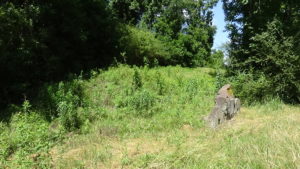A Center for Tory Activity
Description
 Located here was the McPhaul’s Mill complex, started in 1761 by Scottish immigrant John McPhaul and his son Neill. According to a booklet for the unveiling of the related state highway marker (on NC 211):
Located here was the McPhaul’s Mill complex, started in 1761 by Scottish immigrant John McPhaul and his son Neill. According to a booklet for the unveiling of the related state highway marker (on NC 211):
“Old John McPhaul had been a miller in the old country and had brought his millstones with him. He and his son, finding the run of the Little Raft admirably suited to their purpose, soon built a grist mill which drew customers from far and near among the many Scottish Emigrants (sic) who eventually settled thickly there between the waters of the Cape Fear and Pee Dee Rivers. With the passing years, the mill and tavern became a gathering place for the community.[1]

Neill fought against independence with part-time Loyalist (“Tory”) militia. What now is farmland to the right of the memorial served as a campsite for Tories multiple times during the war. Col. David Fanning led an early morning raid on the Chatham County Courthouse (near modern Pittsboro) in July 1780 and captured 53 Patriots. His force and its prisoners camped here on the way to a British corps occupying Wilmington.
On Sunday, July 22, some of the prisoners pen a letter here to Gov. Thomas Burke—but it reads a lot like messages kidnappers force their hostages to write![2] It says of the Loyalists, “Some had been unlawfully Drafted, Others had been whipped and ill-treated, without tryal (sic); Others had their houses burned, and all their property plundered, and Barbarous and cruel Murders had been committed in their Neighborhoods.” Then the authors apparently pass along a threat from Fanning: “unless an immediate stop is put to such inhuman practices we plainly discover the whole country will be deluged in Blood, and the innocent will suffer for the guilty.” Nonetheless, they say, “We have been treated with the greatest Civility and with the utmost respect and politeness by our Commanding Officer, Col. Fanning…”
They said they expected to arrive in Wilmington in a few days “entirely destitute of Money or Cloathes (sic). How long we shall remain so, God only Knows.” One of them was paroled to take the letter to Burke, with the understanding he would return to Wilmington. Apparently the men were held prisoner by the British until the end of the war.
At the height of the “Tory War” between partisans of both sides, in 1781:
- Fanning and 155 men stopped here on a supply run from his base near modern-day Ramseur to the British encampment at Wilmington, and returned in late August. While they are here, a messenger informs him that Col. “Old Hector” O’Neill has skirmished with a Patriot force now camped eight miles to the northwest. Fanning sends a courier offering his help, which O’Neill accepts. Early on Saturday, September 1, the Tory force marches off to win the Second Battle of Beattie’s Bridge.

Thomas Burke Fanning’s troops capture Gov. Thomas Burke and much of the Patriot state government in Hillsborough two weeks later. It again stops here on the way down to Wilmington and comes back afterward. (Fanning was not with it, having been severely wounded on the way down at the Battle of Lindley’s Mill).
- The Tory armies of Cols. Duncan Ray and “One-Eyed” Hector O’Neill (including Fanning’s men) are still camped here in mid-October, drilling for future action. They learn the larger Patriot militia army of Brig. Gen. Griffith Rutherford is marching on them. On Monday, October 15, they rush out of the camp. Some disappear into the swamp. Most withdraw to what they think is a better defensive position a few miles away. The Patriot army appears from the north (to the right if facing the monument). Maj. Joseph Graham reported, “When we came in sight of that place, smoke like that of a camp appeared, and we made dispositions for attack.” When they arrive here, though, only two Tories are left, one in a British uniform. He tries to escape, no doubt headed downhill to cross the swamp by the mill, but is captured with a wound to his head, Graham says. He tells them they missed the Tories by only a half hour. Graham is ordered to follow them, resulting in victory at the Battle of Raft Swamp (also known as the Battle of McPhaul’s Mill).
- Rutherford’s army camps here during that action. The cavalry returns after ending their search for prisoners at the battle site due to darkness, and head out again the next day to continue.

After the war:
- The tavern was a stopover for the Marquis de Lafayette, the French volunteer with the Continental Army who became a protégé and friend of Gen. George Washington, when he toured America in 1825.
- The complex eventually had a cotton gin, distillery, and sawmill as well. It apparently fell into disuse shortly before the Civil War.
What to See
The millstones, and foundation stones from the mill, are in the memorial. The mill was likely to the left, near where the road crosses the swamp. But if any trace remains, it isn’t visible to the public. The mound behind the memorial could be what is left of the tavern.


More Information
- Bullock, Beatrice, ‘McPhaul’s Mill’, NCGenWeb, 1933 <http://ncgenweb.us/hoke/mcphaulmill.html> [accessed 29 January 2020]
- ‘Commemorative Landscapes of North Carolina’, 2010 <https://docsouth.unc.edu/commland/monument/711/> [accessed 29 January 2020]
- ‘David Fanning, Hated Tory Leader Staged Raid at Chatham Court House Here in 1781 and Captured 53 Prominent Citizens of County’, Chatham Record (Pittsboro, N.C., 20 September 1962)
-
Graham, William A. (William Alexander), General Joseph Graham and His Papers on North Carolina Revolutionary History (Raleigh, N.C.: Edwards & Broughton, 1904) <http://archive.org/details/cu31924032738233> [accessed 27 March 2020]
- ‘Marker: I-50’, North Carolina Highway Historical Marker Program <http://www.ncmarkers.com/Markers.aspx?MarkerId=I-50> [accessed 27 January 2020]
- ‘Marker: I-51’, North Carolina Highway Historical Marker Program <http://www.ncmarkers.com/Markers.aspx?MarkerId=I-51> [accessed 26 January 2020]
- Ramsey, Herndon, et al., ‘Letter from Herndon Ramsey, et al. to Thomas Burke, Volume 22, Pages 550-551’, Documenting the American South: Colonial and State Records of North Carolina, 1781 <https://docsouth.unc.edu/csr/index.php/document/csr22-0402> [accessed 5 June 2023]
- ‘Sketch of McPhauls Mill, Robeson County, NC’, Cape Fear Clans, 1959 <http://www.capefearclans.com/McPhaulsMillSketch.html> [accessed 29 January 2020]



